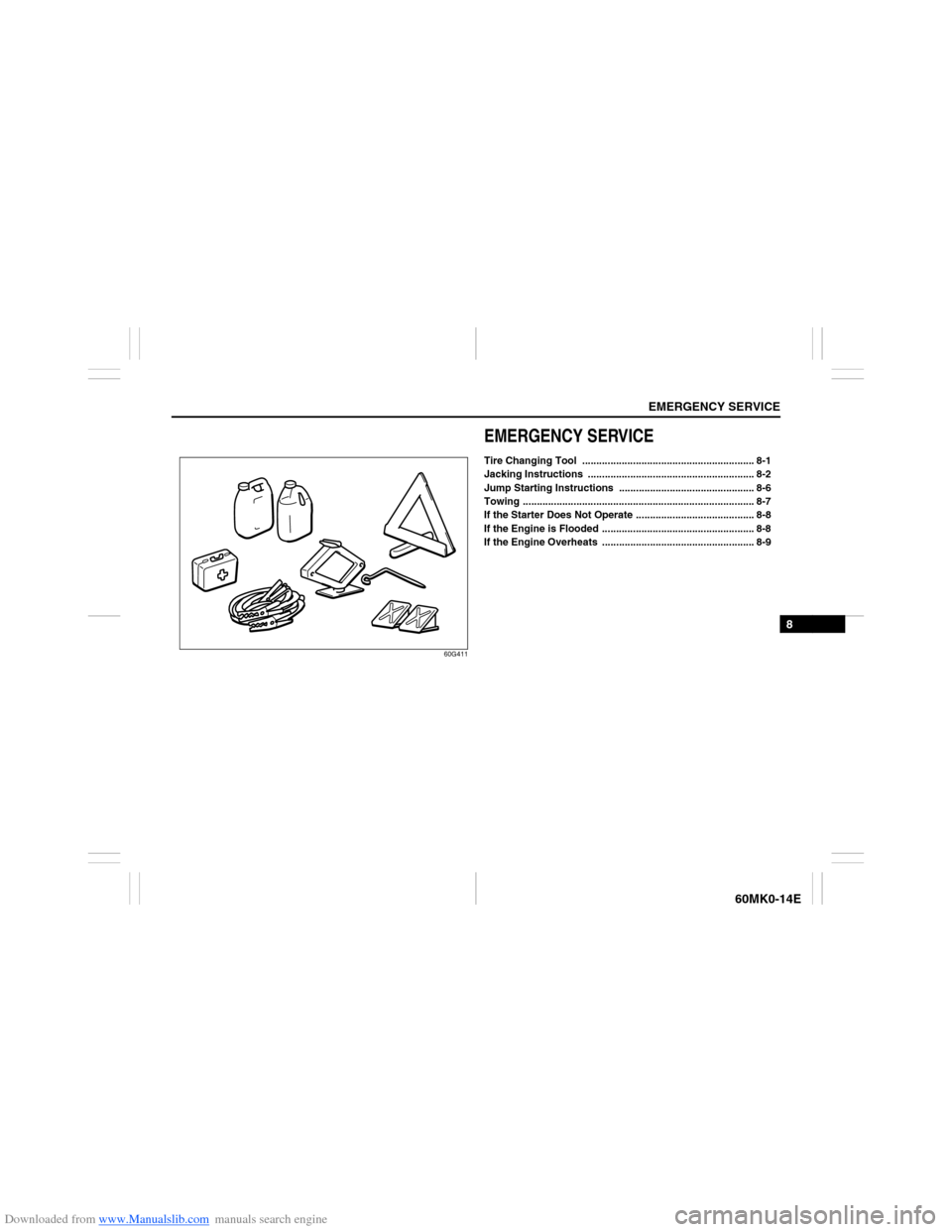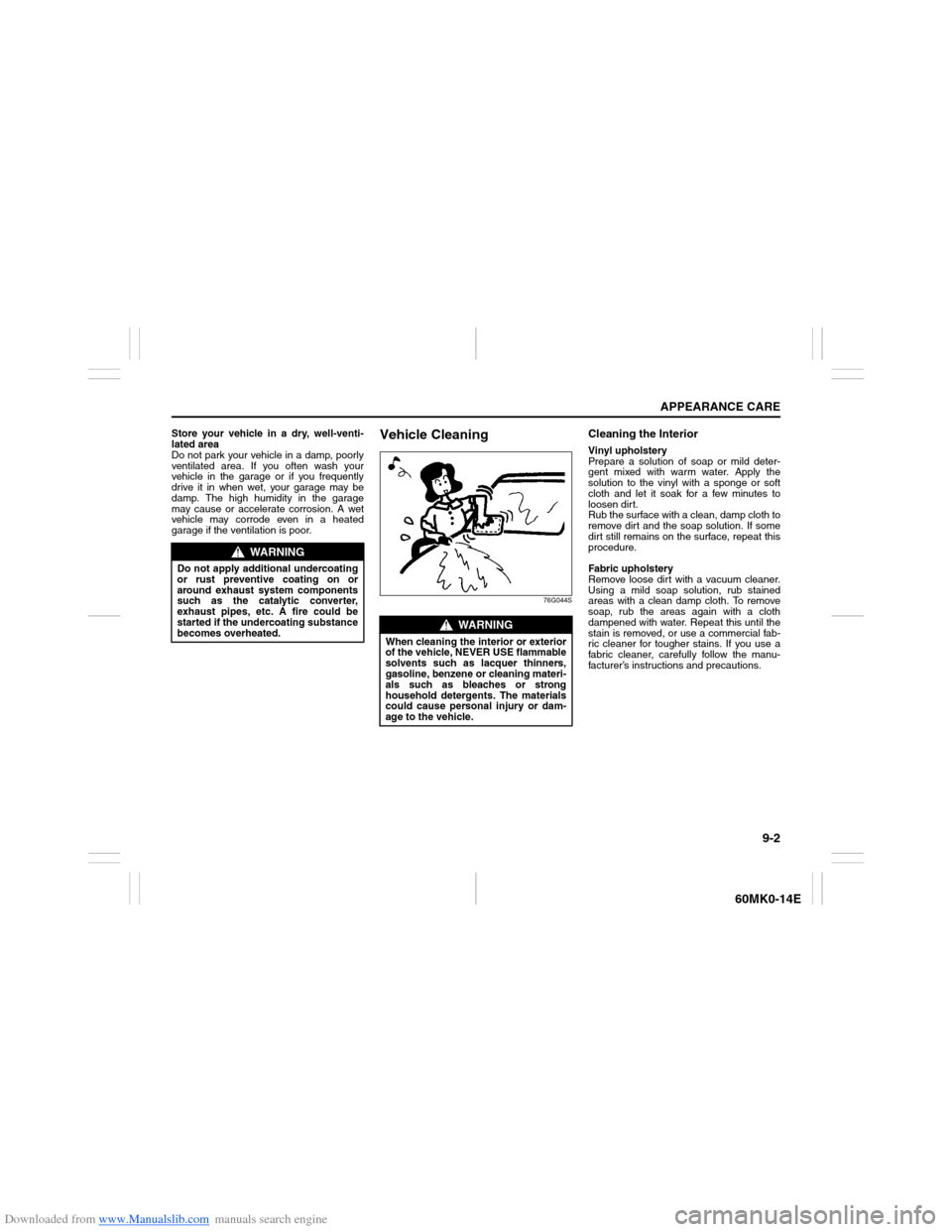2013 SUZUKI ERTIGA engine overheat
[x] Cancel search: engine overheatPage 156 of 207

Downloaded from www.Manualslib.com manuals search engine 7-11INSPECTION AND MAINTENANCE
60MK0-14E
Refill with Oil and Check for Leaks1) Pour oil through the filler hole and
install the filler cap.
For the approximate capacity of the oil,
refer to the “Capacities” item in the
“SPECIFICATIONS” section.
2) Start the engine and look carefully for
leaks at the oil filter and drain plug. Run
the engine at various speeds for at least
5 minutes.
3) Stop the engine and wait about 5 min-
utes. Check the oil level again and add
oil if necessary. Check for leaks again.
Engine CoolantSelection of CoolantTo maintain optimum performance and
durability of your engine, use SUZUKI
Genuine Coolant or equivalent.
This type of coolant is best for your cooling
system as it:
Helps maintain proper engine tempera-
ture.
Gives proper protection against freezing
and boiling.
Gives proper protection against corro-
sion and rust.Failure to use the proper coolant can dam-
age your cooling system. Your authorized
SUZUKI dealer can help you select the
proper coolant.
NOTICE
When replacing the oil filter, it is
recommended that you use a genu-
ine SUZUKI replacement filter. If
you use an aftermarket filter, make
sure it is of equivalent quality and
follow the manufacturer’s instruc-
tions.
Oil leaks from around the oil filter
or drain plug indicate incorrect
installation or gasket damage. If
you find any leaks or are not sure
that the filter has been properly
tightened, have the vehicle
inspected by your SUZUKI dealer.
NOTICE
To avoid damaging your cooling sys-
tem:
Always use a high quality ethylene
glycol base non-silicate type cool-
ant diluted with distilled water at
the correct mixture concentration.
Make sure that the proper mix is 50/
50 coolant to distilled water and in
no case higher than 70/30. Concen-
trations greater than 70/30 coolant
to distilled water will cause over-
heating conditions.
Do not use straight coolant nor
plain water.
Do not add extra inhibitors or addi-
tives. They may not be compatible
with your cooling system.
Do not mix different types of base
coolants. Doing so may result in
accelerated seal wear and/or the
possibility of severe overheating
and extensive engine/automatic
transaxle damage.
Page 171 of 207

Downloaded from www.Manualslib.com manuals search engine 7-26
INSPECTION AND MAINTENANCE
60MK0-14E
81A283
Headlight AimingSince special procedures are required, we
recommend you take your vehicle to your
SUZUKI dealer for headlight alignment.
Bulb Replacement
WARNING
Always be sure to replace a blown
fuse with a fuse of the correct amper-
age. Never use a substitute such as
aluminum foil or wire to replace a
blown fuse. If you replace a fuse and
the new one blows in a short period
of time, you may have a major electri-
cal problem. Have your vehicle
inspected immediately by your
SUZUKI dealer.
BLOWN OK
CAUTION
Light bulbs can be hot enough to
burn your finger right after being
turned off. This is true especially
for halogen headlight bulbs.
Replace the bulbs after they
become cool enough.
The headlight bulbs are filled with
pressurized halogen gas. They can
burst and injure you if they are hit
or dropped. Handle them carefully.
NOTICE
The oils from your skin may cause a
halogen bulb to overheat and burst
when the lights are on. Grasp a new
bulb with a clean cloth.
NOTICE
Frequent replacement of a bulb indi-
cates the need for an inspection of
the electrical system. This should be
carried out by your SUZUKI dealer.
Page 181 of 207

Downloaded from www.Manualslib.com manuals search engine EMERGENCY SERVICE
8
60MK0-14E
60G411
EMERGENCY SERVICETire Changing Tool ............................................................. 8-1
Jacking Instructions ........................................................... 8-2
Jump Starting Instructions ................................................ 8-6
Towing .................................................................................. 8-7
If the Starter Does Not Operate .......................................... 8-8
If the Engine is Flooded ...................................................... 8-8
If the Engine Overheats ...................................................... 8-9
Page 190 of 207

Downloaded from www.Manualslib.com manuals search engine 8-9EMERGENCY SERVICE
60MK0-14E
If the Engine OverheatsThe engine could overheat temporarily
under severe driving conditions. If the
engine coolant temperature gauge indi-
cates overheating during driving:
1) Turn off the air conditioner, if equipped.
2) Take the vehicle to a safe place and
park.
3) Let the engine run at the normal idle
speed for a few minutes until the indica-
tor is within the normal, acceptable
temperature range between “H” and
“C”.If the temperature indication does not
come down to within the normal, accept-
able range:
1) Turn off the engine and check that the
water pump belt and pulleys are not
damaged or slipping. If any abnormality
is found, correct it.
2) Check the coolant level in the reservoir.
If it is found to be lower than the “LOW”
line, look for leaks at the radiator, water
pump, and radiator and heater hoses. If
you locate any leaks that may have
caused the overheating, do not run the
engine until these problems have been
corrected.
3) If you do not find a leak, carefully add
coolant to the reservoir and then the
radiator, if necessary. (Refer to “Engine
Coolant” in the “INSPECTION AND
MAINTENANCE” section.)
NOTE:
If your engine overheats and you are
unsure what to do, contact your SUZUKI
dealer.
79J007
WARNING
If you see or hear escaping steam,
stop the vehicle in a safe place and
immediately turn off the engine to let
it cool. Do not open the hood when
steam is present. When the steam
can no longer be seen or heard, open
the hood to see if the coolant is still
boiling. If it is, you must wait until it
stops boiling before you proceed.
WARNING
It is hazardous to remove the radia-
tor cap (or degassing tank cap for a
diesel engine) when the water tem-
perature is high, because scalding
fluid and steam may be blown out
under pressure. The cap should
only be taken off when the coolant
temperature has lowered.
To help prevent personal injury,
keep hands, tools and clothing
away from the engine cooling fan
and air-conditioner fan (if
equipped). These electric fans can
automatically turn on without warn-
ing.
Page 193 of 207

Downloaded from www.Manualslib.com manuals search engine 9-2
APPEARANCE CARE
60MK0-14E
Store your vehicle in a dry, well-venti-
lated area
Do not park your vehicle in a damp, poorly
ventilated area. If you often wash your
vehicle in the garage or if you frequently
drive it in when wet, your garage may be
damp. The high humidity in the garage
may cause or accelerate corrosion. A wet
vehicle may corrode even in a heated
garage if the ventilation is poor.
Vehicle Cleaning
76G044S
Cleaning the InteriorVinyl upholstery
Prepare a solution of soap or mild deter-
gent mixed with warm water. Apply the
solution to the vinyl with a sponge or soft
cloth and let it soak for a few minutes to
loosen dirt.
Rub the surface with a clean, damp cloth to
remove dirt and the soap solution. If some
dirt still remains on the surface, repeat this
procedure.
Fabric upholstery
Remove loose dirt with a vacuum cleaner.
Using a mild soap solution, rub stained
areas with a clean damp cloth. To remove
soap, rub the areas again with a cloth
dampened with water. Repeat this until the
stain is removed, or use a commercial fab-
ric cleaner for tougher stains. If you use a
fabric cleaner, carefully follow the manu-
facturer’s instructions and precautions.
WARNING
Do not apply additional undercoating
or rust preventive coating on or
around exhaust system components
such as the catalytic converter,
exhaust pipes, etc. A fire could be
started if the undercoating substance
becomes overheated.
WARNING
When cleaning the interior or exterior
of the vehicle, NEVER USE flammable
solvents such as lacquer thinners,
gasoline, benzene or cleaning materi-
als such as bleaches or strong
household detergents. The materials
could cause personal injury or dam-
age to the vehicle.
Page 204 of 207

Downloaded from www.Manualslib.com manuals search engine 12-2INDEX
60MK0-14E
Driving range........................................................................ 2-49EElectric Power Steering Light ............................................. 2-42
Electric Window Controls ................................................... 2-11
Emergency Locking Retractor (ELR) ................................. 2-22
Engine Coolant .................................................................... 7-11
Engine Hood......................................................................... 5-38
Engine Oil and Filter .............................................................. 7-7
Engine Oil Consumption ....................................................... 3-2
Engine Serial Number ......................................................... 10-1
Exhaust Gas Warning............................................................ 3-1FFloor Mats............................................................................. 5-45
Fluid Control Clutch ............................................................ 7-16
Fluid Level Check ................................................................ 7-16
Folding Rear Seats .............................................................. 2-18
Footrest ................................................................................ 5-45
Frame Hooks ........................................................................ 5-46
Front Air Bags ...................................................................... 2-31
Front Fog Light Switch........................................................ 2-52
Front Seat Back Pocket....................................................... 5-44
Front Seats ........................................................................... 2-14
Fuel Filler Cap ...................................................................... 5-37
Fuel Gauge ........................................................................... 2-44
Fuel Recommendation .......................................................... 1-1
Full Wheel Cover.................................................................... 8-5
Fuses .................................................................................... 7-23
Fuses in the Engine Compartment .................................... 7-23
Fuses under the Dash Board .............................................. 7-25
GGasoline Engine ..................................................................... 1-1
Gasoline/Ethanol blends ....................................................... 1-1
Gear Oil ................................................................................. 7-15
Gear Oil Change ................................................................... 7-15
Gear Oil Level Check ........................................................... 7-15
Gearshift Lever ....................................................................... 3-9
Glove Box ............................................................................. 5-42HHazard Warning Switch ....................................................... 2-53
Head Restraints ........................................................... 2-15, 2-17
Headlight Aiming.................................................................. 7-26
Highway Driving ..................................................................... 4-3
Horn ....................................................................................... 2-56
How the ABS Works............................................................. 3-14IIf the Engine is Flooded......................................................... 8-8
If the Engine Overheats ......................................................... 8-9
If the Starter Does Not Operate............................................. 8-8
If Your Vehicle Gets Stuck .................................................... 4-5
Ignition Key Reminder ........................................................... 2-2
Ignition Switch........................................................................ 3-3
Immobilizer System ............................................................... 2-1
Immobilizer System Light.................................................... 2-41
Improving Fuel Economy ...................................................... 4-2
Information Display.............................................................. 2-46
Inside Rearview Mirror......................................................... 2-13
Installation with a Lap Belt .................................................. 2-29
Installation with Lap-Shoulder Seat Belts ......................... 2-29
Instantaneous Fuel Consumption ...................................... 2-48
Instrument Cluster ............................................................... 2-36